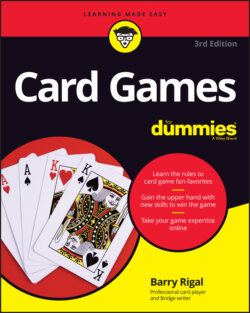Читать книгу Card Games For Dummies - Barry Rigal - Страница 22
Playing the Game
ОглавлениеThe most important phase of most card games resides in the play of the hand. In many of the games in this book, the objective is to try to accumulate points — or, in a game like Hearts, to try to avoid accumulating points.
The standard way of accumulating or avoiding points derives from the concept that a game is made up of several distinct phases; in each phase (except for certain games like Poker and Blackjack), players detach cards from their hands and put them face-up on the table, in order. Whoever plays the highest card in the suit led usually gets to collect all those cards and stack them face-down in front of them. This unit of playing cards is called a trick — your success in many competitive card games hinges on how many tricks you win during the course of play. (Again, however, some games in the book, such as Setback, feature trying to win specific valuable cards rather than simply trying to obtain the majority of the tricks.)
So the high card takes the trick. But how do you get to that point? Here are the steps that get you there:
1 The first player to act makes the opening lead, or the lead to the very first trick.Depending on the rules of the game, the elder hand (the player to the dealer’s left), the dealer, or the player who selected the contract during the bidding process makes the opening lead.
2 The player who wins the trick generally leads to the next trick and so on throughout the hand, until everyone plays all their cards.The order of play nearly always follows a clockwise or occasionally counterclockwise pattern in relation to the deal or the winner of the trick.
The player who wins the trick makes the next lead and scores or avoids points. But it doesn’t always take the high card to win the trick, and sometimes you make mistakes during the course of a hand. The following sections detail tricks and penalizing treats.
